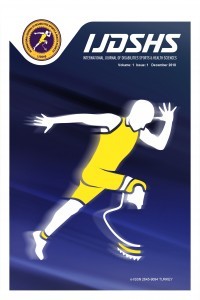The Relationship Between Clinical Motor and Communication Levels of Children with Cerebral Palsy, And Competencies From Parents' Perspectives
The Relationship Between Clinical Motor and Communication Levels of Children with Cerebral Palsy, And Competencies From Parents' Perspectives
Cerebral Palsy, Motor Level, Communication Skills, Parent Perspective,
___
- Cans, C., De-la-Cruz, J., & Mermet, M. A. (2008). Epidemiology of cerebral palsy. Paediatrics and child health, 18(9), 393-398.
- Carlsson, A. M. (1983). Assessment of chronic pain. I. Aspects of the reliability and validity of the visual analogue scale. Pain, 16(1), 87-101.
- Coleman, A., Weir, K., Ware, R. S., & Boyd, R. (2015). Predicting functional communication ability in children with cerebral palsy at school entry. Developmental Medicine & Child Neurology, 57(3), 279-285.
- Drougia, A., Giapros, V., Krallis, N.,Theocharis, P., Nikaki, A., Tzoufi, M., & Andronikou, S. (2007). Incidence and risk factors for cerebral palsy in infants with perinatal problems: a 15-year review. Early human development, 83(8), 541-547.
- Ejraei, N., Ozer, A. Y., Aydogdu, O., Turkdogan, D., & Polat, M. G. (2021). The effect of neck-trunk stabilization exercises in cerebral palsy: randomized controlled trial. Minerva Pediatrics.
- Hankins, G. D., & Speer, M. (2003). Defining the pathogenesis and pathophysiology of neonatal encephalopathy and cerebral palsy. Obstetrics & Gynecology, 102(3), 628-636.
- Hidecker, M. J. C., Paneth, N., Rosenbaum, P. L., Kent, R. D., Lillie, J., Eulenberg, J. B., & Taylor, K. (2011). Developing and validating the Communication Function Classification System for individuals with cerebral palsy. Developmental Medicine & Child Neurology, 53(8), 704-710.
- Kakooza-Mwesige, A., Andrews, C., Peterson, S., Mangen, F. W., Eliasson, A. C., & Forssberg, H. (2017). Prevalence of cerebral palsy in Uganda: a population-based study. The Lancet Global Health, 5(12), e1275-e1282.
- Katz, S., Ford, A. B., Moskowitz, R. W., Jackson, B. A., & Jaffe, M. W. (1963). Studies of illness in the aged: the index of ADL: a standardized measure of biological and psychosocial function. Jama, 185(12), 914-919.
- Krageloh-Mann I, Cans, C. (2009). Cerebral Palsy Update. Brain and Development, 31, 537- 544.
- Leung, C. Y. S., & Li-Tsang, C. W. P. (2003). Quality of life of parents who have children with disabilities. Hong Kong Journal of Occupational Therapy, 13(1), 19-24.
- Lim MSY, Wong CP (2009). Impact of cerebral palsy on the quality of life in patients and their families. Neurulogy Asia, 14, 27–33.
- Mutlu, A., Pistav-Akmese, P., Yardımcı, B. N., & Ogretmen, T. (2017). What do the relationships between functional classification systems of children with cerebral palsy tell us? Journal of Physical Therapy Science, 28(12), 3493-3498.
- Palisano, R., Rosenbaum, P., Walter, S., Russell, D., Wood, E., & Galuppi, B. (1997). Development and reliability of a system to classify gross motor function in children with cerebral palsy. Developmental medicine & child neurology, 39(4), 214-223.
- Serdaroǧlu, A., Cansu, A., Özkan, S., & Tezcan, S. (2006). Prevalence of cerebral palsy in Turkish children between the ages of 2 and 16 years. Developmental Medicine and Child Neurology, 48(6), 413-416.
- Stavsky, M., Mor, O., Mastrolia, S. A., Greenbaum, S., Than, N. G., & Erez, O. (2017). Cerebral palsy—trends in epidemiology and recent development in prenatal mechanisms of disease, treatment, and prevention. Frontiers in Pediatrics, 5, 21.
- O’Shea M (2008). Cerebral Palsy. Seminars in Perinatology, 32, 35–41.
- Wood, E. (2006, December). The child with cerebral palsy: diagnosis and beyond. In Seminars in pediatric neurology (Vol. 13, No. 4, pp. 286-296). WB Saunders.
- Yıldız, A., Tarakcı, D., Hajebrahimi, F., & Mutluay, F. (2016). Disabled children's functionality and maternal quality of life and psychological status. Pediatrics International, 58(12), 1291-1296
- Yayın Aralığı: Yılda 3 Sayı
- Başlangıç: 2018
- Yayıncı: Nevzat DEMİRCİ
Emre Serdar ATALAY, Güler ATALAY
Turgay ALTUNALAN, Deniz DEMİRCİ, Sinem GÜL, Ahsen ÖZTEL
Seveka BALİ, Devi DAYAL, Amrit Pal Singh SOOD, Sougata PANDA, Priyanka GUPTA
Selma ERCAN DOĞU, Ayşe Gökçen GÜNDOĞMUŞ
Effect of Physical Activity Interventions in Autism Spectrum Disorder
Return to Job of A Construction Worker by Comprehensive Functional and Vocational Rehabilitation
Sandeep SHİNDE, Pradnya GHADAGE
Effect of Pranayama Exercise on Breath-Holding Capacity of Soccer Players
Laishram Santosh SİNGH, Salam Opendra SİNGH, Oinam Puya DEVİ, Waribam James SİNGH, Sarungbam Sen SİNGH
Yeliz BÜYÜKTEPE, Emre ŞENOCAK, Aysel YILDIZ ÖZER
Burnout, Anxiety and Coping Attitudes in Parents of Children with Autism Spectrum Disorder
